At Fort Johnson, on the western edge of Amsterdam, NY, I got my first look at the Mohawk River. Here on the riverbank in 1749 Sir William Johnson, one of the most powerful white men in 18th century America, built his third Mohawk Valley residence. He was thirty-four.
The Mohawk River, the largest tributary of the Hudson, flows generally east through the Mohawk Valley. It was the waterway used by many British sympathizers in their flight to Upper Canada during and after the American Revolution. (Laura Secord's family, the Ingersolls, travelled 100 miles against the current of the Mohawk before portaging to Oneida Lake. Then it was on to Port Oswego and the final leg of their journey across Lake Ontario.)
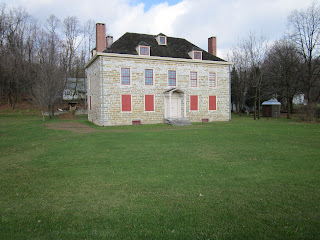 |
| Fort Johnson, home of William Johnson & Molly Brant |
|
|
Around 1759, Sir William brought the young Mohawk woman, Molly Brant, to live with him as his wife in Fort Johnson, the name he gave this stone manor house. William Johnson was forty-four; Molly in her early twenties. Here at Fort Johnson a number of their children were born.
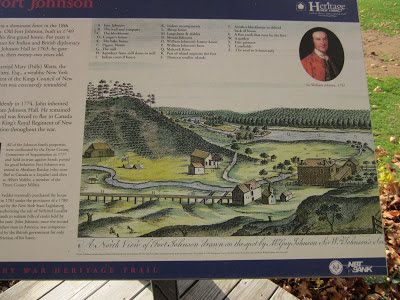 |
| Plaque showing a northern view of Fort Johnson, Sir William's estate. | | |
|
|
From Fort Johnson we followed Route 5 along the Mohawk River, west towards Palatine Bridge where we crossed to the south side of the waterway and the village of Canajoharie. This village is named after the Upper Mohawk Castle where Molly was born, about 1736.
Unfortunately, Wintergreen Park that affords public access to the overlook above Canajoharie Falls was closed for the season. Here, millions of years ago a glacial river cut a three-mile gorge through the rock.
"Canajohie" means "a pot that washes itself" and it was so-called by the Mohawk people because of a large circular pothole, ground into solid rock near the lower end of the gorge through which the creek flows. The name was used for the Upper Mohawk Castle as well as the creek, the gorge, the falls, and today's village.
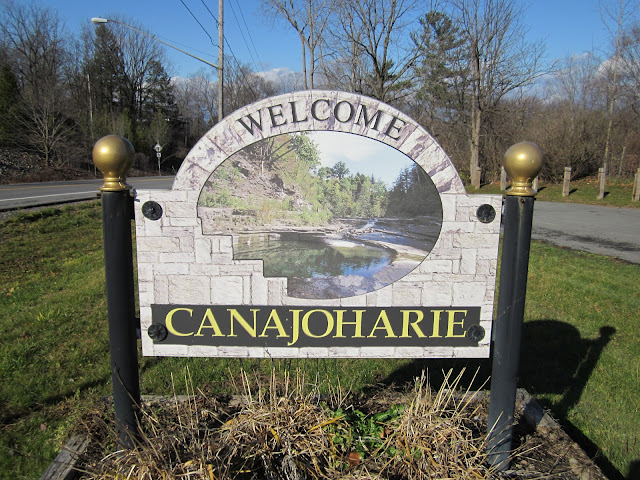 |
| Village sign with photo of "the pot that washes itself." |
Back in town, we visited the very attractive Canajoharie Library and Art Gallery, one of the finest small art galleries in the US. Here we were able to pick up brochures and maps of the area and talk to the very helpful staff. The art gallery's core collection consists of 350 paintings by American artists, including 21 oils and watercolours by Winslow Homer. It is well worth a visit.
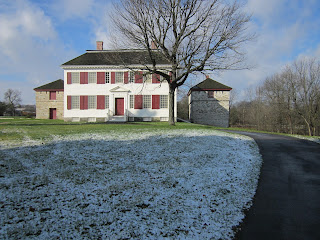 |
| Johnson Hall |
We spent a few days last week on the trail of Molly Brant, the subject of my latest research. I always find it helps me get to know someone if I can spend a bit of time poking about in their familiar surroundings.
With Johnstown, NY as our destination we crossed the border and headed south east, following Rte 12, which we later discovered was not the shortest route but certainly the most attractive. We'd left the traffic behind on the interstate and now travelled winding country roads, up and down hills, and round endless curves.
Just as I was thinking that whatever was at the end of the narrow twisting, road wasn't going to be much, there it was — a city, no less!
Where does a retired librarian go to get information? To a library, of course, and we were there almost as soon as it opened the next morning. I wish I'd gotten the name of the woman at the circulation desk, who was so patient with my questions and who went to no end of trouble digging up maps and information for me. Yes, all librarians are supposed to be that helpful. but we know it isn't always true.
Before leaving Johnstown we visited Johnson Hall, the home Sir William Johnson (1715–1774) built for Molly Brant and their family in 1763.
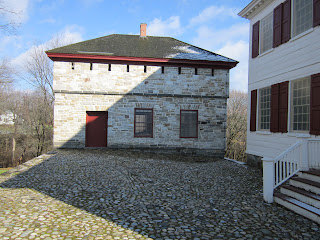 |
| Cobblestone courtyard behind Johnson Hall and east stone house. |
|
|
The Georgian house, built of wood and clapboard cut to look like stone, was the second manor house Sir William, Superintendent of Indian Affairs for the Northern Colonies, had shared with his partner, Molly Brant. It was the centre of Sir William's estate and the scene of many Indian conferences, and here Molly had presided as housekeeper and gracious hostess to a long line of important diplomats and their wives. Many of the original buildings in Johnstown were built under the direction of Sir William, and as activity increased around the Hall the surrounding community grew.
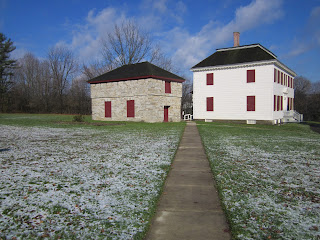 |
| Well-tended grounds at Johnson Hall. |
Although Johnson Hall was closed for the season, all locked and shuttered, when we visited, we were able to stroll the grounds that included a cobblestone courtyard behind the house, the two stone blockhouses, and vast surrounding park.
Then it was time to head on to the next stop on our self-guided tour: Fort Johnson and the house where Sir William brought Molly, the young Mohawk maiden, to live as his wife.
Stay tuned!
Whenever I do a reading or a book signing of my latest title, someone will ask the inevitable question, "What are you writing now?"
It used to be that I would circle around the answer, always avoiding telling what the new story was about, believing I could jinx it before it ever saw the light of day. (I believe this because it's happened to me.)
I acknowledge that in order to be happy I have to be writing
something. I've always loved working with words — my own or editing those of someone else. Lately, my writing has taken a different tack. I am helping a gentleman get his personal recollections ready to be published in a book.
Currently, I visit him once a week with my digital voice recorder, and he tells me the stories as they occur to him. He has lived in this town for more than 85 years and is a fount of knowledge of its history. A history buff myself, I am thrilled to be able to help preserve these memories.
After I have transcribed his words and edited them into a readable form, I email them to him to read. Before we record another session we will go over those pages together, making revisions. Another rewrite and edit, and they will be ready for him to make the final revisions.
Stay tuned!
Last winter, the Spirit of the Hills writers' group to which I belong decided to publish the first anthology of our work. It would be our way of celebrating "October is Arts Month" in Northumberland County.
Now the book has arrived, an attractive paperback, published by Blue Denim Press. For more information, please go to the publisher's website
http://www.bluedenimpress.com/hill-spirits.phpHill Spirits contains a wide variety of short stories, poems, and art from twenty-one Spirit of the Hills contributors. My own contributions are a prose piece I think of as a kind of reverie, called "Summer Sojourn" and a short story, a murder mystery, entitled, "The Good Neighbour."
The book is being launched in grand style this month and next at several different locations in the area — Cobourg, Port Hope, Colborne, Brighton, Norwood, Trenton, as well as at The Rivoli in Toronto.
A few of the contributors will be reading from their own creations at each of the launches. I am among a group reading on October 28th in Brighton at an invitation-only luncheon. Please contact Lighthouse Books (613 475 1269) if you'd like attend.
I'll also be reading here in Trenton on October 30th at the Arts Quinte West Gallery at 7:00 p.m. Here is the poster with all the information you'll need to attend this event. I hope to see you there!
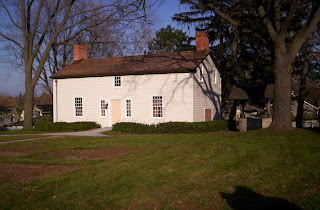 |
| The restored Secord Homestead, Queenston, ON. |
My calendar shows a number of readings coming up this fall. I'm in the midst of developing a slide presentation of images related to the life of Laura Secord. And I'm counting on the pictures to add some variety to my usual talk and to stimulate some discussion with my audience. The following are a few that I have chosen.
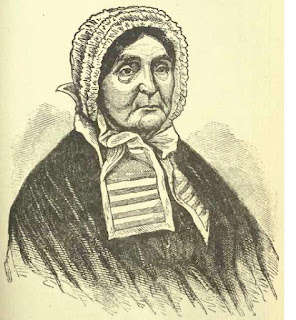 |
| Laura Secord in later years. |
This sketch is taken from what is, my research tells me, the only authentic photograph of Laura Secord. It was taken by Mr. Joel Lyons of Chippewa and appeared for the first time in a book in 1869, a year after Laura's death. Laura was only thirty-seven when she made her heroic walk, but there are no pictures of it, nor did she leave us a first-hand account of her adventure.
Little is known of her first twenty years except that she was born September 13, 1775 in Great Barrington, in the colony of Massachusetts.
This is one of the last photographs of the house in Great Barrington where Laura Ingersoll grew up. It was demolished in 1913 to make way for a library on the site. Below is an artist's impression of the same house.
On a day designated as "Laura Secord Day," October 18, 1977, the Great Barrington Historic District Commission unveiled this plaque in front of the library.
I find it especially interesting that this is an American tribute to a Canadian, Laura Secord, a recognition of a heroine from the other side of the War of 1812. To me, that's a class act.
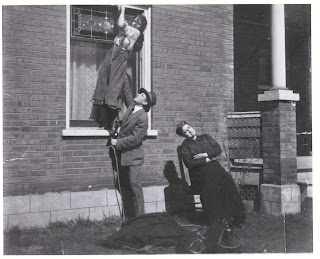 |
| Scene from "Modern Eden," a movie made in Trenton in 1918. |
|
|
In 1917 a Toronto film company built a movie studio in what might seem an unlikely location — Trenton, Ontario.
Those who remember the years of Trenton's early film industry recall the thrill of seeing movie stars on the streets of town, shopping at local stores, or enjoying hockey games at the old Quinte Street Arena, wrapped in their coonskin coats.
They remember heads turning as the famous British film director, Captain Bruce Bairnsfather, went by in his chauffeur-driven car, its hood ornament twice the size of a man's hand.
That is how I began my first book,
The Movie Years (Mika, 1989), the story of those few, colourful years when my home town was Hollywood North.
The first five-reel film for Canadian National Features was "The Marriage Trap," starring Marguerite Snow and Herbert Prior. That same year, filming got underway on "Power," starring Holbrook Blinn, Mable Trunnelle, and other American film stars. Although Canadian National Features went into receivership before either picture could be released, they did appear in 1918, marketed by another company. Both movies premiered at the Strand in Toronto, and newspaper ads declared them "the most pretentious produced in the Dominion so far."
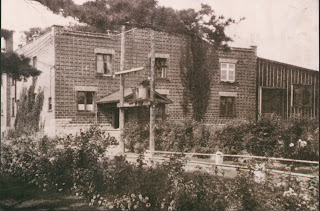 |
| The Trenton Movie Studio |
|
|
The names of those early actors meant little to me twenty-five years ago when I was writing
The Movie Years. But when I was more recently researching the career of Mary Pickford for my book
Mary Pickford, Canada's Silent Siren, America's Sweetheart (Dundurn, 2011) and I encountered them again, they seemed to spring off the page at me.
Although I never discovered anything to indicate Mary Pickford had ever been at the Trenton Studio, I found it interesting that some of the silent movie stars who had worked here in Trenton went on to appear in movies with the fabulous Pickford.
Holbrook Blinn, who starred in "Power" in 1917, played the king opposite Pickford in the acclaimed silent film "Rosita", directed by Ernst Lubitsch.
Herbert Prior ("The Marriage Trap") had an interesting career. Early on he was a member of the Edison Stock Co. and the D.W. Griffith Stock Co., later joining Biograph where Mary got her start in moving pictures, under the direction of the brilliant D.W. Griffith. Prior was married to Mabel Trunnelle, who also played in "Power," here in Trenton.
Prior, an English-born actor, and Trunnelle made scores of films together. They were known as Hollywood's favourite couple until they were eclipsed by none other than Mary Pickford and Douglas Fairbanks.
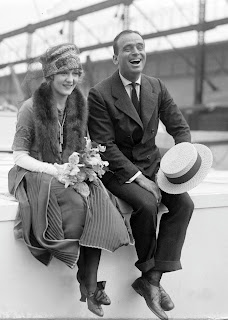 |
| Mary and Doug, Hollywood's favourite couple. |
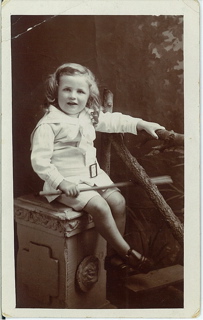
My father loved words.
He was not what you'd call an educated man. He never went to college, never earned a university degree. In fact, he left his home in England in 1923 at the age of seventeen, having passed his high school "O Levels." He came to Canada, reconnected with some of his cousins here, found work, got married, and spent a number of years in the RCAF during and after World War II. He and my mother, an elementary school teacher, raised a family of five children.
A lifelong reader, Dad used to send for secondhand books, mostly classic literature, from a book dealer in England. I remember his look of eager anticipation as he opened his jackknife to cut the string that bound the neatly wrapped, brown paper package containing two or three of the books he'd been waiting for.
My father was the one we went to if one of us wanted to know the meaning of a word we'd come across in our own reading, even though we knew his answer would always be the same: "Look it up in the dictionary."
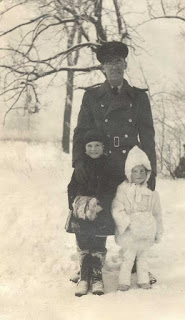 |
| In Quebec City. Dad, my sister Mary, and myself. Wearing fur was the fashion in the Forties. |
Dad had a large vocabulary and an elegant way of expressing himself in the many letters he wrote home to the "old country" or to us kids after we'd left the nest. When he and my mother — another avid reader— had both retired, they played a game of "Scrabble" together every evening for the rest of their lives.
After his death, twenty years ago now, I chose several volumes of my father's treasured books for my own library. Dad owned a number of dictionaries and I claimed one, also his
Bartlett's Familiar Quotations, Roget's Thesaurus of the English Language, Modern English Useage, and several volumes of his favourite classics that ranged from Charles Dickens to
The Rubaiyat of Omar Khayyam.The five of us were fortunate to be raised by such loving and literate parents.
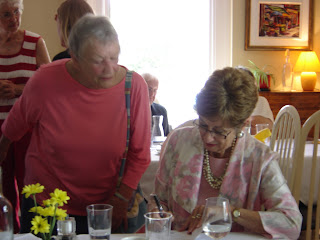 |
| Signing copies of "Laura Secord, Heroine of the War of 1812" at The Gables |
Over the past year or two I've attended a number of Author Luncheons sponsored by Lighthouse Books in Brighton, ON. Buying a ticket to one of these events entitles you to a signed copy of the guest author's book, some pleasant dinner companions, and a gourmet meal prepared by a fine chef at The Gables restaurant. The Gables occupies the main floor of an elegant, older home, surrounded by mature shade trees and attractive gardens. Inside, the walls of the dining rooms come alive with glorious original paintings.
In the past I've enjoyed hearing guest authors Jane Urquhart and Charlotte Gray read from their latest works, and earlier this year, Adrienne Clarkson led a lively discussion on the immigrant experience, after reading from her book,
Room For All of Us. Richard Gwynne too has been a guest at one of these events.
You can imagine my delight/surprise at being asked if I'd like to be the guest of honour at a luncheon on July 8th. It took a while to get over the initial anxiety that no one would buy a ticket to hear me! But it all turned out very well. Besides friends and family (my loyal supporters), there were even some old acquaintances I never expected, a few people I'd never met until then, and a couple of friends from my writers' group. All in all, a very pleasant Sunday afternoon. Thank you, Ann & Mia.
Please support your independent book stores!!
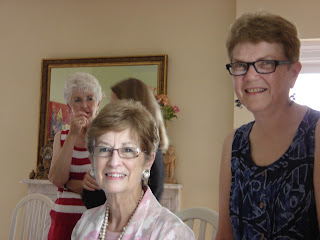 |
| Myself and Mia Woodburn, joint owner (with Ann Dobby) of Lighthouse Books, Brighton, ON |
I have found that what I call
joyful writing is a key to releasing writer's block.
To get past the fear of the blank page you begin to write for the sheer joy of it — for no one but yourself — the way you used to write, back in a time when all your dreams were ahead of you and nothing was standing in your way.
Write about something you're passionate about, something you wished you had done, an adventure you wished you had taken. And don't stop writing because what you are writing is not the truth. That immediately puts on the brakes. Don't listen to the voice that says, "It didn't happen that way." Write it your way, and it becomes your truth.
Rediscover the pleasure of putting words on the page, with no thought of where those words are going, or of who will read them. They belong to you. Those words are moving you closer to the day when you are writing again.
Relax and let it happen.
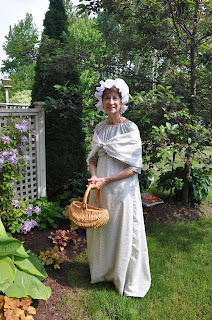
Costumes have never been "my thing." I've never been a big fan of Hallowe'en either (except for the leftover candies). But when my book
Laura Secord, Heroine of The War of 1812 came out this spring, I thought I'd make a costume that I could wear for readings and presentations to promote the book.
The only thing I had to go on when I decided to make a Laura Secord costume was what her daughter Harriet told author Sarah Anne Curzon in 1891. Harriet was James' and Laura's third daughter, and at the age of ten, the only one who saw her mother leave the house at dawn the day of her walk to warn Lieutenant Fitzgibbon. "She had on house slippers and a flowered print gown; I think it was brown, with orange flowers on it," Harriet remembered all those years later.
My dress is cream-coloured cotton, with tiny blue flowers on it. In an earlier life it had been a tablecloth, one I'd made myself years ago. The dress has an empire waistline, popular in the Regency period, and the long skirt, which is slightly longer and fuller in the back, is fully lined. For this dress I used Simplicity costume pattern 4055. The only thing I changed was the length of the sleeves, making them elbow length.
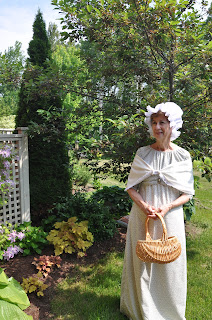
The shawl and mob cap were made from another Simplicity pattern, 3723.
It is more likely that on that hot day — June 22, 1813 — Laura wore a sunbonnet. I chose something that I could make myself, a mob cap or duster, which is what women wore everyday at home in those days.
I would have preferred
not to wear a hat, but it seems to complete the outfit.
I'm including this picture because it shows what I wore on my feet. They are black, ballerina-style slippers, and after spending a whole weekend, June 1–3, wearing them at the Spencerville Mill Bicentennial Heritage Fair, I can say they worked very well.
On Monday, May 28, 2012, I was honoured to be part of a Mary Pickford Party at the Cobourg Public Library. Besides reading from my book,
Mary Pickford, Canada's Silent Siren, America's Sweetheart, and talking about Mary's life and amazing career, I saw for the first time,
Stella Maris, one of Mary's silent films.
This is a view of the large crowd that attended the event. Record numbers, I'm told.
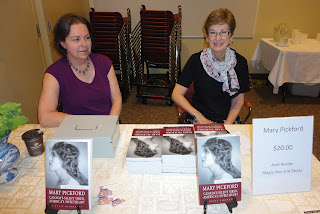
Julie Maynard (left) of The Avid Reader book store in Cobourg ran the book table, and I was there to sign copies during the break for refreshments.
All the treats that afternoon, baked by some talented and generous volunteers, were prepared from recipes that were popular during the 1920s.
Pauline Janitch, tireless volunteer at the Cobourg Public Library, welcomed the audience to a special edition of the regular Monday afternoon at the Movies event. Pauline was the driving force behind this successful event and did most of the planning and publicity.
I was introduced by Charmaine Lindsay, CEO of the CPL. Chris Worsnop, Chair of the Vintage Film Festival, which co-sponsored the event, introduced us to the film we viewed that afternoon,
Stella Maris, made in 1918. It was one of Mary Pickford's most highly-acclaimed silent movies. It was excellent, with Mary playing dual roles in what turned out to be a gripping story.
My thanks to everyone concerned. It was a memorable party.
 |
| A view of the back of the Secord homestead, Queenston, Ontario. |
The story continues from last week's blog.
The press picked up the story of the prince's reward for Laura Secord's bravery, and in 1861 Niagara resident, Emma Currie, read those newspaper accounts.
Who was this woman, Laura Ingersoll Secord, and why had Emma Currie never heard the story of her heroism?
When the Woman's Literary Club was formed in St. Catharines in 1892, twenty-four years after Laura's death, Emma Currie, as its founder, wrote a paper to be delivered at the opening. The subject of her address was Laura Secord.
With further research, Currie's paper became a book that was published in 1900.
The Story of Laura Secord and Canadian Reminiscences to this day remains a respected source of expert information.
If Laura Secord, at the age of eighty-five, had not been so determined to have her name included on a list of veterans of the War of 1812 that was to be presented to the visiting Prince of Wales, and if his subsequent gift had gone unnoticed by the press, the public might have continued to be unaware of the heroine who had lived among them for so many years.
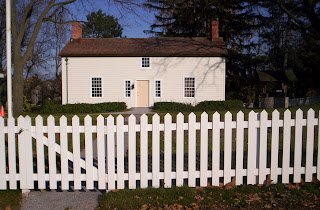 |
| The Secord homestead, Queenston, Ontario |
|
Laura Secord never boasted of her heroism. For years after her 30 km walk to warn a handful of British soldiers at their outpost at Beaver Dams that they were about to be attacked by an army of five hundred Americans, Laura kept silent about it. She and her husband, James, feared reprisals, and the War of 1812 was long over before it was spoken of, even within her family circle.
Laura
did remind the government of her deed in three personal petitions when, years later, the Secords struggled financially. They hoped that James or herself might be given some form of employment by the lieutenant-governor.
In 1860, the Prince of Wales, the future King Edward VII, was to visit Canada and pay homage to the veterans of the War of 1812 and the Rebellion of 1837. Laura, who was then 85, insisted that she be allowed to add her name to an address that the vets were presenting to the royal visitor.
At first, she was refused. But the
Niagara Mail and Empire took up her cause in the press. As a result, permission was given for Laura Secord to travel to Niagara-on-the-Lake where she added her signature to the page. She also wrote a petition for the prince where she asked him to tell his mother, Queen Victoria, the story of Laura's service to her country and the Crown.
Whether or not the prince ever saw Laura's personal petition we can't be sure. But someone drew his attention to the lone woman's signature on the veterans' address. The prince was intrigued and began asking questions about Laura Secord.
A year after his visit to Canada the Prince of Wales sent Laura 100 pounds in gold. It was the only remuneration she ever received for her bravery.
For more of this story, please read my newly-released biography,
Laura Secord: Heroine of the War of 1812
In the past, I've had books released without any type of launch, but never have I had a book with two launches. I feel very privileged that this is going to be the case for my latest,
Laura Secord: Heroine of the War of 1812. The following invitations are for everyone, but depending on where you live, one venue might be better than the other. For those in the part of Ontario where I live — the Quinte, Northumberland, or Prince Edward Country regions — the Prince Edward County Library and Archives is hosting a launch of the book at the Wellington Library, 261 Main St. in Wellington on Sunday, May 27 at 2 p.m. There will be a reading, book signing, a chance to chat, and some light refreshments.
For those who live in the Brockville, Prescott, Ottawa area the Spencerville Mill Heritage Fair is hosting the launch at the ArtScene Gallery at 11 Spencer St. in Spencerville on Friday, June 1 at 5 p.m. The organizers are calling it a launch and soiree. There'll be a meet and greet, a short reading, a book signing, and some light refreshments.
My launch here is part of the Spencerville Mill's Bicentennial Heritage Fair, June 1–3, a whole weekend of activities on a War of 1812 theme. Here is the link:
http://www.spencervillemill.ca/bicentennial-heritage-fair.html Click on "Schedule & Map" for more information. On Saturday, June 2 , I'll be signing books at the mill on Water Street from 1–2 p.m.
Everyone is welcome to come to these Bicentennial celebrations. Come in costume and you'll fit right in. I'll be wearing a Regency period "everyday" dress, a style that Laura herself might have worn.
I recently had the privilege of giving a presentation to the Grades 4, 5, and 6 students at C.M.L. Snider Public School in Wellington, ON to celebrate Literacy Day. My visit was sponsored by the Rotary Club of Wellington.
I read a few short selections from one of my novels,
Trouble at Turtle Narrows, and shared some stories and slides of my writing life.
The audience of about seventy students, their teachers, and a few parents was enthusiastic and attentive. Best of all, they had plenty of questions for me!
You are cordially invited to come to the party! All things Mary Pickford, including some tempting desserts.
A fellow writer, who happens to be a young friend of mine, writes a blog that I've been following for some time. She has graciously granted me permission to share a link to a recent posting of hers.
http://www.sunshineinajar.com/?p=5317This one struck a chord with me, now that I am finished my latest book and wondering what's next. Why do we writers feel guilty if we're not writing, or if we're writing for the joy of it and not thinking of publication? Jessica reminds us that it's okay to just be still, quiet for a while, because in that quiet we find our voice, connect to our deepest selves.
I'm sure you'll enjoy this post.
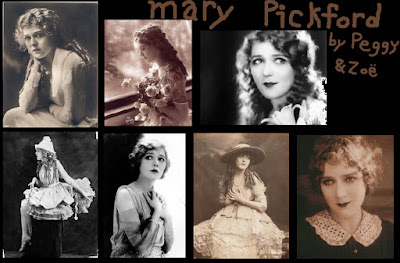 |
| The many faces of Mary Pickford |
According to biographer Scott Eyman (
Mary Pickford: America's Sweetheart), Pickford was "criticized by the highbrows for her extraordinary appeal to the masses." Her audiences were mainly women and children. She was the "girl next door," and she didn't go too far afield because she knew who her fans were and what they wanted.
Personally, I'm not sure it's fair to criticize Mary for that. It makes good business sense, and Mary was a shrewd businesswoman.
Certainly Mary Pickford was more conservative than her swashbuckling husband Douglas Fairbanks, and she worked on a smaller scale. But that was her choice. Eyman contends that she could have done more, been more versatile.
"My career was planned," Mary said later. "There was never anything accidental about it. It was planned; it was painful; it was purposeful. I'm not exactly satisfied, but I'm grateful."
What more can anyone ask?
When I first saw the painting that would be used on the cover of my upcoming biography,
Laura Secord, Heroine of the War of 1812, I became curious about who the artist might be.
His name was Henry Sandham, and he lived from 1842 to 1910. The painting, titled "Laura Secord," can be seen on the Collections Canada website where it is part of a set of reproductions, "Canadian Historical Paintings," that feature the works of C. W. Jeffries and Henry Sandham.
Henry Sandham was born in Montreal where his father and two brothers had a house-painting business in the Griffithtown area of the city. Henry decided against going into the family business, determined instead to pursue an artistic career. His father strongly disapproved and withdrew his support, leaving the boy on his own. At fourteen, Henry got a job as an errand boy at the studio of Montreal photographer William Notman. By the age of eighteen, Henry became the assistant to John Arthur Fraser at the Notman Studio.
Although there was no art school in Montreal at the time, Notman added an art department to his studio in 1860. Henry got his training there though his contact with John Fraser and three other local artists. He married Fraser's sister Agnes in 1865, and by 1868 he was head of the art department.
Henry Sandham's watercolours and oil paintings were part of the landscape movement that characterized Canadian art at the time of Confederation.
In 1877 Sandham illustrated his first article in the New York magazine
Scribner's Monthly. A painter, illustrator, and photographer, he was made a charter member of the Royal Canadian Academy of Art in 1880. Sandham eventually settled in Boston where he was able to concentrate entirely on his art. In 1901 he moved to London, England, and he died there in 1910.
I've had to do some switching of gears lately. I am preparing for presentations and launches, and readying myself to answer questions about a number of different books I've written.
Now, a journalist is doing an article about the early movie industry in Trenton that was the subject of my first book,
The Movie Years, back in 1989. Can we arrange a time to talk about it? I dig through the pile of boxes that hold my research notes. NOTE TO SELF: Keep that box on top. Every few months someone inquires about the story.
With the publication of my biography of
Mary Pickford still fairly recent (it was released seven months ago) and still very much on my mind, I am about to launch the biography of
Laura Secord. I am giving a talk on each of them on successive days. Sometimes I worry about getting the significant dates in Mary's life mixed up with those in Laura's!
At least it's easier to keep track of the names of the characters in the biographies. Last month saw me delivering a talk to school children about one of my middle grade novels. I had to keep reminding myself that Joel was the name of the main character in that particular story. Not Martin, or Jesse, or Mark.
But I
do remember that it was Laura Secord who rescued her husband from the battlefield at Queenston Heights, and Mary Pickford who won the first Oscar for an actress in a talkie.
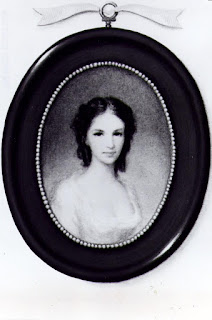 |
| A young Laura Ingersoll Secord. |
For me, one of the challenges in writing about a life that has been over for 144 years is how to make the subject live again, to make her story interesting.
Laura Ingersoll Secord had three different mothers by the time she was fourteen. Her birth mother died when the girl was only eight, leaving behind Laura and her three little sisters. The loss of her young mother was a tragedy made even more devastating when, a week later, Laura's father arranged for the baby, six-month-old Abigail, to be adopted.
Within fifteen months, Thomas Ingersoll married again. Although it was said of this wife that she introduced the art of needlework and drawing into the Ingersoll home, she died of tuberculosis after only four years.
Four months later Thomas married for the third and last time. This marriage lasted until his death in 1812 and produced seven more children.
In writing
Laura Secord: Heroine of the War of 1812 I had the liberty of dramatizing a number of events in Laura's life — providing those events actually happened. One thing I did not do, however, was put any words into Laura's mouth that could not be documented. Writing these scenes helped me in my desire to breathe life into this Canadian heroine, to make her "real" for my readers.
The first scene I chose to dramatize is the one that opens the book. It takes place on that day when Laura learns that her baby sister is not coming back. I wrote the scene through the eyes of that eight-year-old child.
Look for Laura's story in bookstores in May!
Today, March 28th, marks the anniversary of the 1920 marriage of Mary Pickford and Douglas Fairbanks. The "wedding of the century," as it was dubbed, took place twenty-six days after Mary's divorce from the troubled Owen Moore.
The wedding itself was a private ceremony in Los Angeles, at the home of a Baptist minister. Mary wore a gauzy white dress with apple green trim.
When the news of the marriage broke two days later it incited a fan frenzy, and the world acknowledged the popular couple as Hollywood Royalty.
 |
| Mary & Douglas setting off on their honeymoon. |
According to Pickford biographer Gary Carey, "Their honeymoon was the most conspicuous in the history of marriage. They reigned at Pickfair [their Beverly Hills home] as the king and queen of Hollywood for more than a decade."
You can find out more about this famous celebrity couple in my book,
Mary Pickford, Canada's Silent Siren, America's Sweetheart.
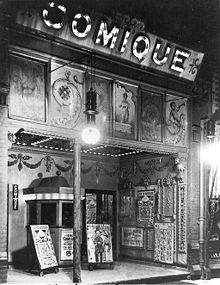 |
| See movies for a nickel. |
It was serendipitous my coming across the book. Published in 1952, it had been a library discard that I bought for a quarter years ago. The dust cover was long gone; someone's puppy had chewed on one corner. Ugly, in other words. But the title,
The Magic Lantern, got my attention. I suspected when I got around to reading it, that it would have something to do with early motion pictures.
I'd been interested in the birth of the movies ever since I began the research on what would become my first book,
The Movie Years, published back in 1989. Two years ago I got another opportunity to delve into that fascinating history again when I started work on
Mary Pickford, Canada's Silent Siren, America's Sweetheart (Dundurn, 2011).
All this time, the book by Robert Carson has languished on my book shelf, gathering dust, until the other day when I was looking for something to read. Just as I'd hoped, it is a fictionalized account of early Hollywood. The central character is the son of movie mogul, Frank Silversmith. The novel takes the reader from the vaudeville stage, the nickelodeons and the advent of the flickers, on to the days when movie studios were springing up on vacant " lots" all over Los Angeles.
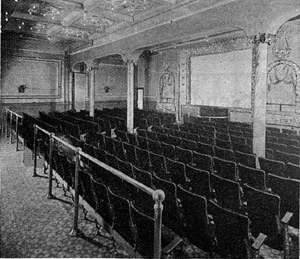 |
| An early movie theatre |
I don't know which studio boss Silversmith, of "Silversmith Productions" is based on, but I recognized much of the background information in the book because it closely follows the history of the birth of Hollywood. It was fun to encounter real life film pioneers in the story, people like D. W. Griffith, Douglas Fairbanks, Charlie Chaplin, and Mary Pickford.
Two interesting bits of trivia I later discovered: Author Robert Carson's wife, Mary Jane Irving (1909–1983), was a child star of the silent films just as Mary Pickford had been. And Carson won an Academy Award in 1938 for his well-known screenplay,
A Star is Born.
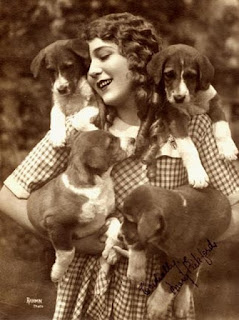 |
| Mary Pickford and friends. |
The late Herbert Whittaker, distinguished Canadian theatre critic, once dubbed Mary Pickford "Toronto's most famous daughter." Although Mary was the most stunning example of a Canadian performer adopted into the American theatrical family, there were others.
Clara Morris (1848–1925), an actress, dancer, and writer, was also Toronto-born. Vaudevillian Eva Tanguay (1878–1947) was born in Marbleton, Quebec; and comedienne May Irwin (1862–1938) and her sister Flo were from Whitby, Ontario.
I've already written here about the tragic life of Florence Laurence (1886–1938), who was born in Hamilton, Ontario. The original "Biograph Girl," she never recovered from the trauma she suffered during a studio fire, and Laurence ended her own life by ingesting ant paste.
Like Mary Pickford, these women all began their professional careers as children. The theatre provided the means of escaping poverty for them and their families. Unfortunately there was not enough happening in Canadian theatre in the early years to allow them to stay in this country.
View Next 25 Posts



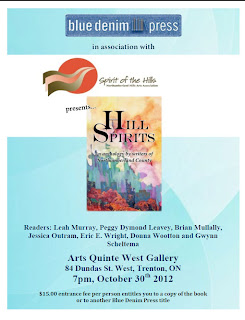






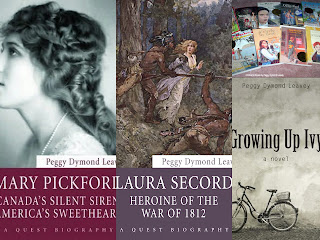







Good points, Peggy. It's always easy to look for flaws in anyone's actions, perceived flaws taken from a modern perspective aren't necessarily so.
Thanks, I appreciate your taking the time to comment :)
I haven't read your book on Mary Pickford, so I'm probably "preaching to the choir" here, but while it is true that viewing the past through modern eyes -- i.e., "judging" the past according to current values gives one a distorted picture of history. Revisting that past in order to understand how a culture developed through a modern eyes can give "eye-opening" results and a new perspective on the past. This is probably truer in the case of Mary Pickford than almost any figure in the arts of the 20th century. I recently commented on another website during a discussion of the MPI funding controversy, and you can find those comments (hopefully) here:
http://thecinementals.org/2012/04/episode-004-in-praise-of-pickford/
And I've written several essays on Mary Pickford at my site:
http://11east14thstreet.com/